ॐ सांई राम
Introduction:
All the festivals are celebrated in Shirdi, but
the three important festivals are, Ramanavami, Guru Poornima and Vijayadashmi.
These are celebrated with great pomp and show. Each is a three-day event and the
temples are decorated beautifully with lights, shamianas and look like heaven.
In the evenings there are cultural programmes and bhajans by famous artists.
There is annadan on the main utsav day of these three festivals. The Prasadalaya
serves free meals.
The Shirdi Saibaba Sansthan, sanctioned by the
district court of Ahmednagar had after mutual deliberations entrusted the
management of the Rama Navami Utsav to Das Ganu Maharaj and Tatya Kote.
The second major utsav was Guru Poornima and it
was managed by Gopalrao Mukund Butti. The sons of the late Gopalrao Butti,
managed this Utsav till 1940. From 1941 the Sansthan managed this festival. The
descendants of Butti send donations for this festival to date.
Baba’s Punyatithi was entrusted to Baba’s
devotees outside Shirdi especially from Mumbai. The permanent fund of the
Sansthan had been started from the savings of the collections and contributions
of the first Bhandara, which was held on the 13th day of Baba’s Mahasamadhi in
1918.
The festival of Gokulashtami was entrusted to the
villagers of Shirdi headed by Tatya Kote Patil.
During all the festivals the Palkhi and Rath were
taken in procession through the village. The Rath stopped a while in front of
Dixit Wada. There Bhajans and Bharood were performed. Much of these activities
are curtailed now by Shirdi Saibaba Sansthan due to the overwhelming
crowds.
First Day Event:
1. Akhand Parayan reading: A day before the
devotees may submit their names for Adhyay reading. After Evening Arati the
names are drawn by lottery. These names are announced through the mike and the
chapters are allotted. Thus 53 chapters are allotted with a standby list of five
names.
'Name lists' are pasted at various places for the
convenience of devotees. After Kakad Arati Baba's photo and 'the Pothi' is
brought in procession from Samadhi Mandir via: Gurusthan to the Dwarakamai. The
Chopdars surpass themselves giving Lalkari at the above temples. In the
Dwarakamai the photo is placed in the 'silver mandap' specially made for this
occasion, along with the Pothi, After Laghu (small Arati) the reading begins.
Since it is Akhand Parayan the Dwarakamai is opened throughout the night. Next
morning the Parayan is completed. Again with music and Bhajans the Pothi and the
Baba's photo is taken back to the Samadhi Mandir.
2. Palki Procession: The Palki is taken in
procession through the village at 8.45 PM. Upon its return to Samadhi Mandir
Shej Aarti is performed.
Second Day:
This is the main Utsav for each festival. Rath
procession through the village.
No Shej Aarti. Samadhi Mandir is kept open the
whole night.
Third Day:
No Kakad Aarti.
Gopal Kaala: Hari Kirtan is started in the
morning ending with Gopal Kirtan. Gopal Kaala signifies the end of the festival
and ceremonies. A beautifully decorated “Dahi Handi” is hung in
the Samadhi Mandir. The honor of breaking it is given to Tatya's descendants.
The contents are distributed to the devotees as Prasad. After Gopal Kaala there
is Noon Aarti.
Gudi Padava, The Maharashtra New Year
This festival is celebrated on Chaitra Shudh
Prathipada i.e., first day of Chaitra Masa (as per the Hindu almanac
March-April). On this day the “Gudi” on a post is hoisted on top of the steeple
of the Samadhi Mandir. The “Gudi” is a copper kalash hoisted on a staff. A new
cloth is draped on it and has small branches of Neem tied to it. It is garlanded
with a flower and “Bathasa Maala” (Bathasa is a cookie made with a concentrated
sugar solution). This is hoisted before sunrise. This is a Brahma Dwaja.


Till the 1950’s and 60’s, the Sansthan used to
perform abhishek to the Samadhi and then distribute the Puran Poli (a sweet
dish) as Mahaprasad. The Samadhi and Baba’s Idol was draped with a beautiful
Shawl of Velvet with ornate Zari Work. The idol was garlanded with a “Bathasa
Maala”. In the Dwarakamai, an ornate garland of roses made of gold was placed on
the portrait. This beautiful garland was donated to the Sansthan by a devotee
named Smt.Indira Pendarkar. This unique celebration has been discontinued by the
Sansthan. Now the Samadhi and Idol is bathed as usual and the Gudi is hoisted
before sunrise. The rath is taken through the village at about 9 p.m. while many
years ago the rath used to be taken through the village between 4 p.m. and 5
p.m. (Refer Shiladhi by Dr.Keshav B.Gavankar).
Ramanavami, the Festival of Rama’s
Birth
On Chaitra Masa Shukla Paksha Navami (March-April
9th Day as per the Hindu Almanac) Ramanavami is celebrated. It was in 1911 that
Ramanavami was first celebrated in Shirdi. The idea originated from the Urs. It
was K.G. Bhishma who conceived of this idea and consulted Kaka Mahajani who
liked the idea and readily agreed. Both of them went to Baba and sought
permission, Baba gave His consent. Since then Ramanavami is celebrated on a
grand scale. It is a three day festival.
On the first day, there is Akhand Parayan
(continuous reading) of Shri Sai Satcharitra. The devotees can submit their
names a day before the festival. In the evening a child is asked to pick up the
chits by lottery. Fifty three names are thus chosen and the chapters are
assigned, and five names are chosen as standby. After the Dhoop Aarti, these
names are announced, and lists are posted at various places. This procedure is
followed for all the three major festivals.
After Kakad Aarti, the Akhand Parayan commences.
The Pothi is brought in procession from the Samadhi Mandir. The procession
consists of a devotee (usually a trustee) who carries the sacred Pothi.
Alongside him another devotee carries a Veena (a stringed musical instrument).
The Veena is symbolic of Saraswati’s Brahma-Veena. Another devotee carries the
portrait of Baba. The Kirtankar (who is also the Pujari) sings all the way from
the Samadhi Mandir to the Dwarakamai.
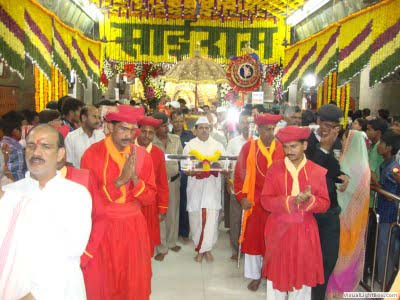
The procession commences with Mantra Upachar,
Laghu Aarti and Lalkari. The procession comes out of the Samadhi Mandir through
the South Gate. Paad Pooja (washing the feet) and Aarti of Camphor are performed
by the Iyer family who reside in Shirdi. The procession then goes to the
Gurusthan where again Mantra Upachar, Laghu Aarti and Lalkari is performed. The
procession then turns right and in front of Dixit Wada Paad Pooja is performed
by the Sansthan. It then proceeds through the Maha Dwar past the Maruti Mandir
to the Dwarakamai. This entourage is followed by numerous devotees.
In the Dwarakamai the area in the verandah next
to the railing is decorated with banana trees. A silver shrine is kept to
welcome Baba’s portrait and the Pothi. A Laghu Aarti is performed to Baba and
the Pothi, then the reading commences. The Dwarakamai is open through the night.
Late in the evening there is Palkhi Procession.
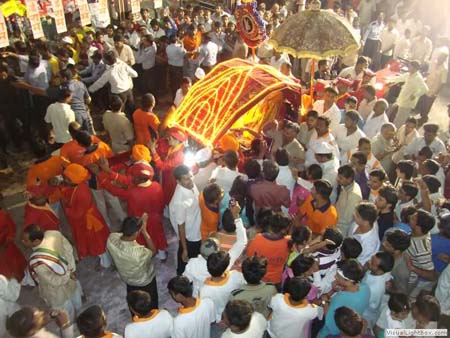
The second day is the Main Utsav (festival) Day.
There is Kakad Aarti. Then after the completion of the Akhand Parayan, the Pothi
is taken in procession to the Samadhi Mandir.
There is Mantra Upachar, Laghu Aarti and Lalkari.
The Pothi is then taken in procession. It exits the Dwarakamai and passes by the
rear of the Samadhi Mandir and enters the Gurusthan where a Laghu Aarti is
performed. The entourage then goes towards the main Dwar of the Samadhi Mandir.
Just before entering the Samadhi Mandir, Paad Puja is performed to the bearers
of the sacred articles by the Sansthan. They then enter the Samadhi Mandir. Thus
the entourage would have completed the Pradakshina of the previous day.
In the Samadhi Mandir there is Mangal Snan (holy
bath of Baba’s Idol). The villagers and numerous devotees go to the Godavari
(Kopergaon) and bring water from Godavari for Baba's Holy Bath. Water is also
brought from the Ganga and other holy rivers by many zealous devotees. The
“Kavadis” (water bearers) are allowed to wash Baba’s Samadhi
and Baba's Padukas with the holy water.
At about 8 a.m. the changing the sack of Wheat
takes place. A new sack of Wheat is brought in procession from the Samadhi
Mandir to Dwarakamai. The old sack is taken to Prasadalay and the new sack is
placed in the cupboard. This tradition was started by Balaji Newaskar. Now the
Sansthan performs this ceremony.
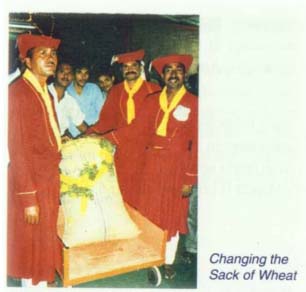
At 12 Noon is the birth of Rama. A cradle is
placed in Samadhi Mandir signifying Rama's Birth. Radhakrishna Mai gave a cradle
when the first time Ramanavami was celebrated in Shirdi and the tradition
continues. Now the Sansthan performs this ceremony. Following this ceremony
there is the noon Aarti.

Between 2 p.m. and 4 p.m., the Changing of the Flags
takes place. This is described in the Shri Sai Satcharitra Chapter 6 in detail.
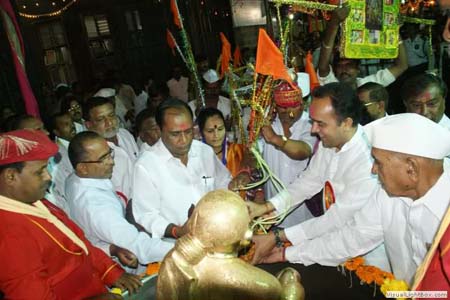
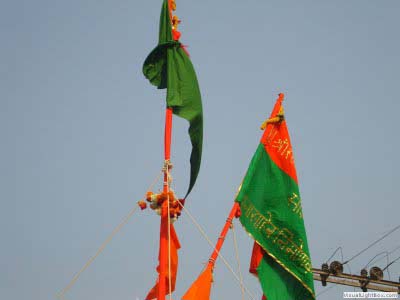
Every year two new flags were taken out in
procession. Since then this ceremony is performed. The descendants of Damu Anna
Rasne supply the embroidered flag, while Nimonkar’s descendants supply the green
flag. These flags are kept on Baba’s Samadhi and Aarti is performed to them.
Then the Noon Aarti takes place. They are taken to Tukaram Sutar’s house (his
surname is Bhalerao and his profession was that of a Sutar or Carpenter). At
about 2 p.m.the gheru flags are brought in a procession from Samadhi Mandir to
the open area in front of Pilaji Gurav's house. Then the other two flags (The
green and embroidered flags) are brought from the Sutar home where they were
fixed to a long staff (pole). After Lalkari Laghu Aarti is done. Then all the
flags are taken in procession through the village with much dancing and
merriment to Dwarakamai. Finally, the two flags (gheru flags – Green and
embroidered flags) are fixed atop the Dwarakamai, while the Ochere flag is fixed
inside the Dwarakamai.
The Urs and Sandal Procession
In 1897 Gopalrao Gund wanted to honor Baba with a
special festival, thus the Urs was started. Urs literally means a wedding with
God or uniting the soul with God at death. It is an annual celebration, and the
saint’s spiritual power is at its peak at that time.
Between 9 p.m. and 10 p.m. the “Sandal
Procession” takes place. The descendants of Abdul Baba perform this. It is a
beautiful ceremony. A platter with sandalwood scrapings along with incense is
taken in procession around the village to the accompaniment of musical
instruments. The platter, the incense and gifts to be offered are carried under
a canopy. This canopy consists of a “Gailif” or “Chaddar” that is attached to
four wooden posts. The Gailif is green in color with golden Kalmas (Kalmas are
verses from the holy Quran) inscribed on it. On top of every post is a Panja (a
silver replica of a hand). This sandal procession is to venerate Auhlias (Muslim
Saints). It is described in chapter 6 of Shri Sai Satcharitra. At the Samadhi
Mandir, gifts like a Chaddar (Shawl), fruits and sweets are offered. The
procession then goes to Abdul Baba’s Darga and again gifts are offered. The
procession ends in the Dwarakamai, where sandalwood mixed with rose water and
Attar (a type of perfume) is pasted on the Nimbar with bare hands.
In the Evening there is the Rath Procession. The
whole right there is Bhajan Sandhya by various invited artists in the Samadhi
Mandir. Thousands of devotees participate in this programme and it joyfully goes
on till the wee hours of the next day. There is no Shej Arati as Samadhi Mandir
is kept open for whole night for Darshan.
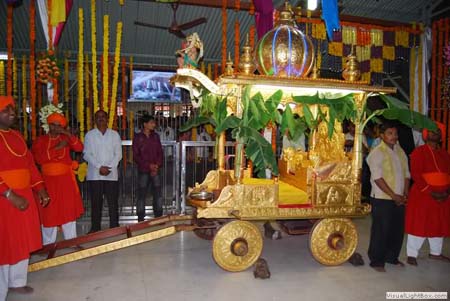
The next morning i.e., on the third day, there is
no Kakad Aarti. Till 12 Noon there is Kaala Kirtan and then the Gopal Kaala is
done. This ceremony is celebrated with joy, merriment and feasting at the end of
the festival. A Handi (earthen pot) filled with the ingredients (mixture of
curds, Lye- puffed Jvari grain, turmeric powder, cumin seeds, coriander seeds
and honey) is hung up and is broken and the contents are distributed. At the
auspicious time it is broken and the contents are distributed as Prasad.
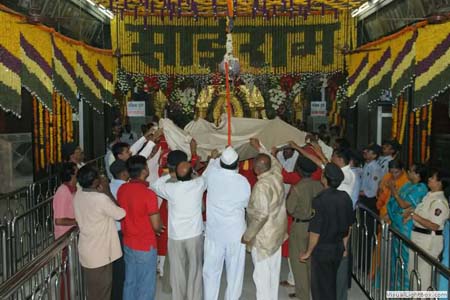
Relation between Saibaba and Rama Navami
Festival
Saibaba celebrated Rama Navami festival right
from the early days of his stay in the Dwarakamai. On that day he washed the
entire Dwarakamai himself. At about 12 noon he bought a little oil and lit a few
lamps. From the rest of the money he bought some Gulal (a dry vermilion powder).
Having done this he first put some on the Dhuni Maa and then on his own head.
Then he put some on each of the steps leading to the Dwarakamai and in every
corner and finally applied some to the entrance door. Later when the devotees
started flocking to Shirdi they had Katha and Kirtan in the Sabhamandap followed
by the birth of Rama, following which Baba distributed Pedas and Burfi (sweets).
(Refer Shiladhi written by Dr.Keshav B.Gavankar).
Pooja of the Sadguru or Guru Poornima
Saibaba accepted Dakshina and Namaskar
(prostrating at his feet) from his devotees. Yet he actively discouraged and
forbade ritualistic pooja directed towards him. Instead he asked them to perform
pooja to the pillar in front of the Dhuni Maa. Baba sat for hours in front of
this pillar leaning his back against it. When the devotees went to the
Dwarakamai at about 5 a.m. they found Baba sitting there gazing into the Dhuni
Maa.
In the year 1910, Tatya Saheb Nulkar, who was a
subjudge in Pandarpur, came to stay in Shirdi. Baba asked him to stay in the
Chavadi. One day, in the morning Baba told Shama, “Ask Mhatara (old man) to
perform pooja to the pillar”. Shama went and told Nulkar (Mhatara) exactly what
Baba had said. Both of them discussed the reason for this, but could not come up
with an answer. At last they consulted the almanac, and found that it was Vyas
Poornima or Guru Poornima Day. But Baba had asked him to perform Pooja to the
pillar, and not to him.
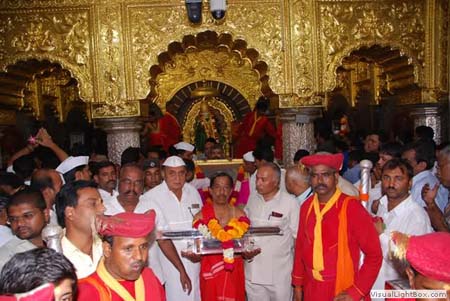
Nonetheless they were very happy that at least he
had allowed pooja to be performed in the Dwarakamai. Nulkar was performing pooja
to the pillar when Shama turned up. Baba said “Why is he performing pooja all by
himself? Why can’t you too perform the pooja? Shama replied “I will not perform
pooja to this pillar. But if you will allow me to perform pooja to you, I will
gladly do so. I will only worship you and not this or any other pillar”. After a
lot of debate and discussion, Baba finally agreed.

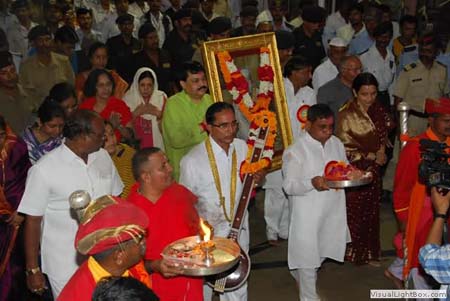
Dada Kelkar was aware that it was Guru Poornima,
so he sent for Tatya who had gone to his farm. Both of them went with pooja
materials, and performed Guru Pooja. The rest of the devotees followed suite.
They offered fruits, dakshina and vastra (dhotis) to their Guru. The dhoti was
of no use to Baba but they got the opportunity to do Guru Pooja that day and
they hoped it would continue in the future.
Thus the festival of Guru Poornima started, and
now it is a three day function. On the first day there is Akhand Parayan, the
second day is the main festival day and it concludes on the third day with Gopal
Kaala. (Refer Shiladhi written by Dr.Keshav B.Gavankar).
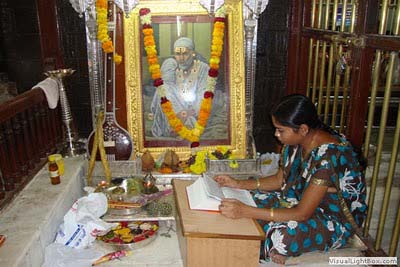
Guru Poornima is celebrated in the Ashad Masa
(June-July). The details of the festival are mentioned below:
First Day: Akhand Parayan. Palki procession
through the village Dwarakamai is kept open the whole night.

Second Day: Is the main Utsav with Rath
procession through the village. There is no Shej Arati as the Samadhi Mandir is
open throughout the whole night for Darshan.

Third Day: No Kakad Arati. Gopal Kaala.
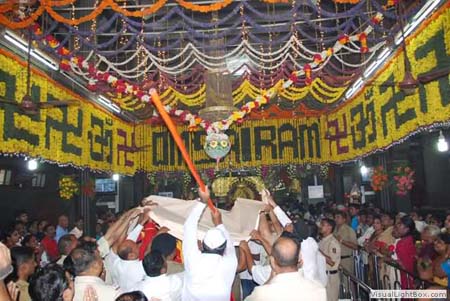

No comments:
Post a Comment